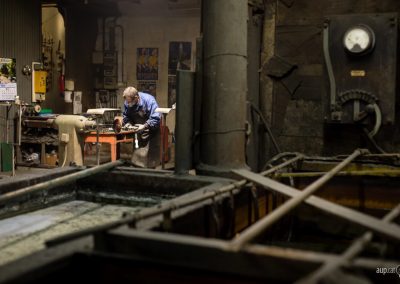P6: Sant Agustí Bridge
Sixth stop
Sant Agustí Bridge
For example, water is an excellent solvent because it is a polar molecule (it’s like a magnet, with one part that has a positive charge and the other negative). Molecules that are part of the mechanisms of life, such as enzymes, ions, etc. are scattered and maintain their electrical charges thanks to this property.

Natural liquid water is never pure and contains many substances that are dissolved or in suspension. Its composition depends on the route its cycle follows, but it is common for water to contain gases present in the air (oxygen, nitrogen, carbon dioxide) and ions that have dissolved from the rocks it has been in contact with, such as sodium, calcium, magnesium, chloride, carbonate, etc.
These carp breathe in a similar way as we do, only instead of using the lungs, they use gills. The oxygen that is dissolved in water is still transported to the cells through hemoglobin. Other animals use different molecules to transport oxygen, such as hemocyanin, which contains two copper atoms, which is why these animals’ blood is not red but blue.
Photosynthesis uses sunlight to turn water and carbon dioxide into an energy molecule called glucose, which is the main food source for all cells. This process takes place in two phases. The first is the light phase, which involves a molecule called chlorophyll. Chlorophyll produces other energy molecules and, as a result, oxygen is released. The second is the dark phase. These energy molecules are used to capture carbon dioxide and produce the precursors to glucose through the Calvin-Benson cycle.
Did you know?
Ice is colorless, although sometimes it looks white if it contains air inside it. When water solidifies, it can result in five different types of crystals, although only one occurs in nature, which has a hexagonal structure. Snowflakes, which are aggregations of ice crystals, are based on this geometry. They usually have six arms and are very flat. Their shape and thickness depend on the temperature and humidity conditions under which they formed.
Recently it has become fashionable to drink the water that results from the thawing of an iceberg, with people saying that that water has been formed over millions of years. In fact, any type of water is formed by hydrogen and oxygen atoms that come from the beginnings of the universe.

Ions
Un ió és un àtom o molécula amb càrrega elèctrica. Si la càrrega és positiva, s’anomena catió. Si la càrrega és negativa s’anomena anió.
Respiració interna
La respiració interna és una funció obligada i constant dels éssers vius, que té l’objectiu d’obtenir l’energia necessària per realitzar la seva activitat. En la respiració es produeix l’oxidació o la deshidrogenació total o parcial de molècules orgàniques de les cèl·lules dels organismes.
Si la respiració és aeròbia, l’oxigen és el responsable de la conversió de les molècules orgàniques a CO2 i H2O. En la respiració anaeròbia no hi intervé l’oxigen, i és la utilitzada per certs microorganismes, com per exemple els responsables de la fermentació alcohòlica.
C6H12O6 + 6 O2 —> 6 CO2 + 6H2O i s’alliberen 36 molècules d’ATP
Cicle de Krebs
El cicle de Krebs és un conjunt de reaccions que permeten la interconversió de molècules orgàniques (glúcids, lípids i restes de pròtids). La transformació d’enzims a diòxid de carboni desprèn energia, que és emmagatzemada per altres molècules com l’ATP, que l’allibera posteriorment per ser utilitzada en els processos de síntesi.

Hemoglobina



















